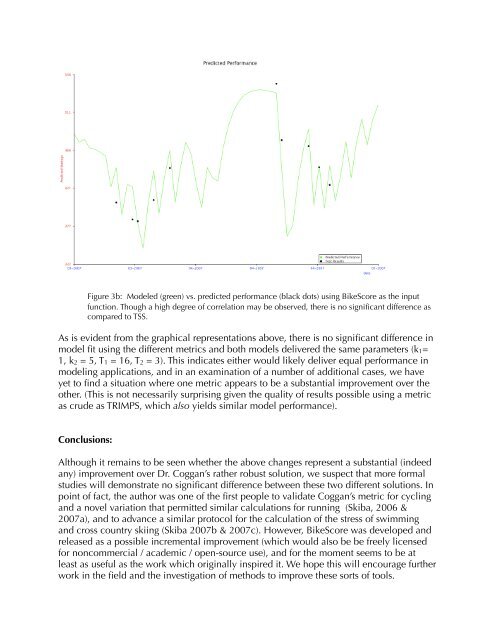bikescore explanation - PhysFarm Training Systems
bikescore explanation - PhysFarm Training Systems
bikescore explanation - PhysFarm Training Systems
You also want an ePaper? Increase the reach of your titles
YUMPU automatically turns print PDFs into web optimized ePapers that Google loves.
Figure 3b: Modeled (green) vs. predicted performance (black dots) using BikeScore as the input<br />
function. Though a high degree of correlation may be observed, there is no significant difference as<br />
compared to TSS.<br />
As is evident from the graphical representations above, there is no significant difference in<br />
model fit using the different metrics and both models delivered the same parameters (k1=<br />
1, k2 = 5, T1 = 16, T2 = 3). This indicates either would likely deliver equal performance in<br />
modeling applications, and in an examination of a number of additional cases, we have<br />
yet to find a situation where one metric appears to be a substantial improvement over the<br />
other. (This is not necessarily surprising given the quality of results possible using a metric<br />
as crude as TRIMPS, which also yields similar model performance).<br />
Conclusions:<br />
Although it remains to be seen whether the above changes represent a substantial (indeed<br />
any) improvement over Dr. Coggan’s rather robust solution, we suspect that more formal<br />
studies will demonstrate no significant difference between these two different solutions. In<br />
point of fact, the author was one of the first people to validate Coggan’s metric for cycling<br />
and a novel variation that permitted similar calculations for running (Skiba, 2006 &<br />
2007a), and to advance a similar protocol for the calculation of the stress of swimming<br />
and cross country skiing (Skiba 2007b & 2007c). However, BikeScore was developed and<br />
released as a possible incremental improvement (which would also be be freely licensed<br />
for noncommercial / academic / open-source use), and for the moment seems to be at<br />
least as useful as the work which originally inspired it. We hope this will encourage further<br />
work in the field and the investigation of methods to improve these sorts of tools.


